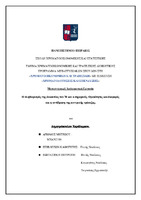Ο πληθωρισμός της δεκαετίας του 70 και ο σημερινός. Ομοιότητες - διαφορές και η αντίδραση της κεντρικής τράπεζας
Inflation of the 70s versus the current inflation. A comparison central bank’s reaction

Προβολή/
Λέξεις κλειδιά
Πληθωρισμός ; Μεγάλος πληθωρισμός ; Νομισματική πολιτική ; Κεντρική τράπεζαΠερίληψη
Ο μεγάλος πληθωρισμός ήταν το καθοριστικό μακροοικονομικό γεγονός του δεύτερου μισού του εικοστού αιώνα. Τις δύο σχεδόν δεκαετίες που διήρκεσε, εγκαταλείφθηκε το παγκόσμιο νομισματικό σύστημα που καθιερώθηκε κατά τη διάρκεια του Β' Παγκοσμίου Πολέμου, υπήρξαν οικονομικές υφέσεις, σοβαρές ελλείψεις ενέργειας και η άνευ προηγουμένου εφαρμογή των ελέγχων μισθών και τιμών σε καιρό ειρήνης. Ήταν, η μεγαλύτερη αποτυχία της μακροοικονομικής πολιτικής στη μεταπολεμική περίοδο. Αλλά αυτή η αποτυχία έφερε επίσης μια μετασχηματιστική αλλαγή στη μακροοικονομική θεωρία και, τελικά, στους κανόνες που σήμερα καθοδηγούν τις νομισματικές πολιτικές των Κεντρικών Τραπεζών σε όλο τον κόσμο. Υπό το φως της εμπειρίας της δεκαετίας του 1970, η περίπτωση για μια παρατεταμένη περίοδο υψηλού πληθωρισμού είναι ξεκάθαρη. Πρώτον, οι διαταραχές του εφοδιασμού που προκλήθηκαν από την πανδημία και το πρόσφατο σοκ εφοδιασμού που προκλήθηκε στις τιμές της ενέργειας από τον πόλεμο στην Ουκρανία μοιάζουν με τα πετρελαϊκά σοκ του 1973 και 1979-1980. Δεύτερον, τότε και τώρα, η νομισματική πολιτική ήταν ιδιαίτερα διευκολυντική στην περίοδο πριν από αυτές τις κρίσεις. Μετά από αρκετούς μήνες πληθωρισμού πάνω από τον στόχο στις μεγάλες προηγμένες οικονομίες, μπορεί τώρα να απαιτηθεί μια πιο απότομη από την αναμενόμενη αυστηροποίηση της πολιτικής για να επιστρέψει ο πληθωρισμός στον στόχο, κάτι που μπορεί να προκαλέσει μια απότομη προσγείωση παρόμοια με εκείνη των αρχών της δεκαετίας του 1980.

